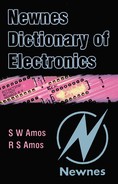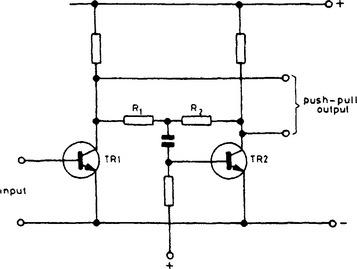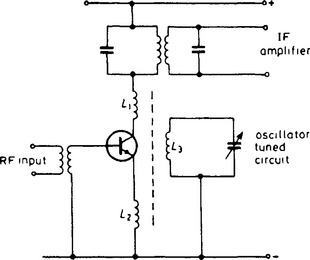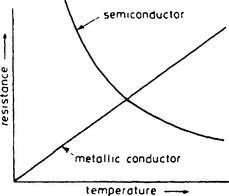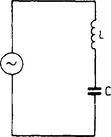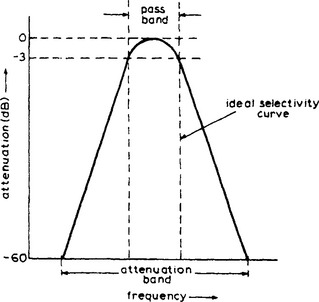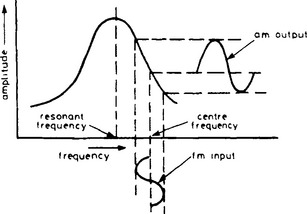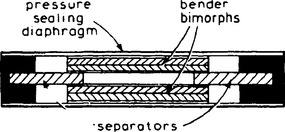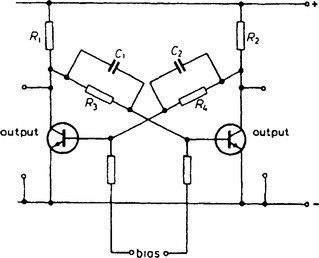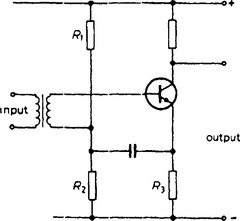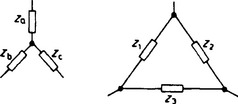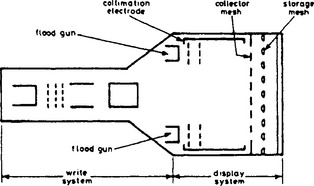S
saddle coils Coils for magnetic deflection, usually of rectangular form and shaped so as to fit the neck of a cathode ray tube.
safe operating area An area on the collector voltage-collector current characteristics of a power transistor within which the operating point should be located to avoid any possibility of overstressing the device. For safe operation of the transistor, the collector current and the collector voltage must not exceed certain values. Moreover the collector dissipation must be kept below a certain limit to avoid overheating. A fourth limit is set by the need to avoid second breakdown (caused by the emitter current concentrating in a particular small area of the junction). To avoid all these limits the values of Ic and Vc must be kept within a safe operating area such as that shown hatched in Figure S.1.
sag Form of distortion of a pulse signal in which the instantaneous amplitude falls during the period of the pulse. The extent of the fall is usually quoted as a percentage of the maximum amplitude. Figure S.2 illustrates 10% sag. An inadequate low-frequency response is the most likely cause of sag.
sample and hold circuit A sampling circuit in which the instantaneous values of a sampled signal are held for a time by storing them in a capacitor. Such circuits are extensively used in analogue-to-digital converters.
sampling The process of obtaining a sequence of instantaneous values of an analogue signal at regular or irregular intervals. If the sampled signal is to represent the original at all closely, the sampling frequency must be at least twice that of the highest-frequency component in the original signal.
sanatron A circuit using two pentodes for producing pulses with a duration linearly related to the amplitude of a control voltage.
saturable reactor An inductor of which the magnetic core is operated in the region of saturation. If the core material is brought near to saturation by DC magnetisation, a superimposed AC can bring about large changes in inductance and hence reactance. Such devices are used in magnetic amplifiers.
saturation (1) In general, a condition in which further increase in input signal to a device gives no increase in output. Thus a magnetically-saturated material gives no increase in flux for an increase in magnetising force and a saturated transistor gives no increase in collector current for an increase in input signal.
(2) In colour perception the degree to which the light energy is confined to a narrow frequency band. It is thus the converse of the extent to which the colour is diluted with white light. The difference between pink and red is one of saturation.
save In data processing to store a file in a storage medium such as a floppy or hard disk.
sawtooth A periodic signal in which each cycle consists of a linear change followed by a rapid return to the value at the beginning of the linear change. The form of the ideal sawtooth is illustrated in Figure S.3. A feature of it is that it is composed entirely of odd-order harmonics. Such signals are used extensively for feeding the deflecting systems in oscilloscopes, picture tubes and camera tubes, and also in the conversion between analogue and digital signals. The linear rise is known as the working stroke and the rapid collapse as the flyback or retrace.
In most generators a sawtooth voltage is developed across a capacitor by passing a constant current through it, flyback being achieved by discharging the capacitor. Such circuits may be free-running, in which case they are usually synchronised by external signals or they may be driven types, in which case external triggering signals are essential to drive them.
scale factor In computers the factor by which quantities must be multiplied to bring them within the range acceptable to the computer.
scale of ten A counting scale containing ten digits. This is the decimal scale normally used in counting. The digits in a decimal number are multiples of the power of ten. As an example the number 4062 is, if written out in full:
scale of two Same as binary scale.
scanner (1) The rotating or oscillating directional antenna used in radar systems. (2) A computer-controlled radio receiver used in communications systems that monitors each of a range of channels in rotation. (3) In computing, a peripheral which converts the contents of a paper document, such as a photograph or a printed page, to a bitmap. It contains an array of photo-sensitive cells, usually charge-coupled devices, which pass over the suitably illuminated document at a controlled speed. The output from each cell is sampled at regular intervals and assembled into the bitmap. The finished bitmap is uploaded to the host computer for viewing or editing. Text in the document may be converted to ASCII code using an OCR application.
scanning In TV the process of analysing or synthesising the light content of the elements constituting the scene. In practice this is achieved by an electron beam which moves over the target of the camera tube or the screen of the picture tube in a series of lines which embrace every element of the image.
scanning lines In TV one of the horizontal rows of elements of which the image is assumed to be composed and which is explored by the scanning beam during transmission and reception. The elements in each line are scanned in order from left to right with a rapid return to the left to start the next line below, and a rapid return to the top of the image when the bottom line has been completed. The motion of the scanning beam is, in fact, similar to that of the eye in reading. The definition of a television system is primarily determined by the number of scanning lines chosen and most modern systems use 525 or 625. Not all the lines are reproduced on receivers because a number are lost during the vertical flyback.
scanning spot In television the small area of the target of a camera tube or screen of a picture tube which is affected by the scanning beam at any instant during the scanning process.
schema The model defining the structure and organisation of a database.
Schmitt trigger A bistable device of which the input has two threshold values. The device takes up one of its two stable states when the input signal reaches a threshold value V1 and remains in this state when the input returns through V1 and until it reaches a second threshold V2, at which the device switches to its alternative stable state. The input must now return through V2 and reach V1 again before the next change of state occurs.
The switching operations clearly lag behind the changes in input signal and the device is sometimes described as having hysteresis. This is indicated in the block symbol for the Schmitt trigger shown in Figure S.4.
Schottky barrier diode Same as Schottky diode.
Schottky diode A diode using a metal/semiconductor junction. The semiconductor is usually highly-doped silicon or gallium arsenide with a thin n-type epitaxial layer. Conduction is entirely by majority carriers and there are no minority carriers to give reverse recovery effects. The diode thus makes an efficient mixer and detector at microwave frequencies.
Schottky diodes start conduction at a low forward voltage (between 0.1 and 0.2 V compared with 0.6 V for a silicon pn diode).
Schottky effect The increase in current from a cathode beyond the saturation value resulting from an increase in anode voltage. The increase is caused by the lowering of the work function of the cathode by the increased electric field at its surface.
Schottky noise Same as shot noise.
scintillation (1) Small random variations of the amplitude, phase or angle of arrival of a received radio wave caused by its passage through the ionosphere. The term is analogous to the twinkling of light from a star. (2) In an amplitude-modulated transmitter unwanted frequency modulation of the carrier. Such modulation can occur when the amplitude modulation depth is great. (3) The flash of light produced in a layer of material, notably a phosphor, when a charged particle strikes it at high speed.
scintillation counter Alpha particle and gamma ray counter in which the incident radiation strikes a phosphor to produce light which is detected by a photocell, the output of which is amplified to operate the counter circuit.
Scophony system System of projection television in which a beam of light is modulated by a Kerr cell and then projected on to a screen after reflection at a rotating system of minors (known as a mirror screw) which gives the required scanning pattern.
scrambler A device which takes an incoming signal and applies an encryption algorithm to it. The resulting scrambled signal is transmitted to the receiver which contains an unscrambler. This applies the reverse of the encrypting algorithm so as to reconstitute the original signal. Scramblers are used to provide security in communications systems to which the public have access.
scratch filter Filter giving attenuation of the higher audio frequencies and used with an AF amplifier to reduce surface noise in the reproduction of early or worn records. The noise of the reproducing stylus in the groove is negligible in modern discs but the abrasive powder formerly included in the material of records intended for reproduction by steel needles causes a hiss or scratching noise which can be reduced by use of a low-pass filter. If the cut-off frequency and/or the rate of fall of response are controllable it is usually possible to find a compromise setting of the controls where the hiss is not objectionable and the musical fidelity not unduly impaired.
scratch pad In computers and data-processing equipment a storage area reserved for intermediate results.
screen Of a cathode ray tube the layer of phosphor which fluoresces under the impact of the electron beam so as to form the required visible display.
screening The use of materials to reduce the penetration of a field into a particular region.
The principle of electric screening can be understood from Figure S.5(a) in which A and B represent two parts of a device or circuit. A is a generator of impedance Z1 and B has an impedance of Z2 to chassis. There is a capacitance C1 between A and B determined primarily by the dimensions of A and B and their distance apart and this can convey energy from A to B. As C1 is a small capacitance its reactance is likely to be large compared with Z1 and Z2, but the energy transfer increases with increase in frequency and at RF may be sufficient to cause instability if B is an early stage in an amplifier.

Figure S.5 (a) The capacitance between two parts A and B of a circuit and (b) interposing an earthed screen between A and B eliminates the direct capacitance between them
To prevent such unwanted feedback an earthed screen may be interposed between A and B as shown in Figure 5.5(b). This eliminates C1 and replaces it by two capacitances C2 and C3 which cannot give feedback provided the screen is of low-resistance material and is connected to chassis via a very low impedance. The screen need not be solid; a mesh is equally effective.
This principle was used in the screen-grid electron tube. The screen grid is located between anode and control grid to prevent feedback from anode to control grid. The screen must not interrupt the electron stream from cathode to anode so it is made of mesh construction and biased positively with respect to the cathode. To provide the low-impedance connection to earth the screen is decoupled by a low-reactance capacitor.
Unwanted coupling can also occur via magnetic fields which can induce EMFs in conductors so leading to instability. At low frequencies this can be avoided by totally enclosing the source of magnetic field in a box of high-permeability material. The stray field will then be confined to the low-reluctance path offered by the screening box. At low frequencies, such as mains and audio frequencies, magnetic screening is not often required because inductors and transformers which are likely to generate magnetic fields usually have magnetic cores which, with proper design, confine the field to the component itself so minimising stray field.
However, at higher frequencies, notably radio frequencies, unwanted coupling via magnetic fields is easily possible and the RF and IF inductors of radio receivers require screening to minimise it. The principle used here is to mount the inductors in a conducting can so that eddy currents are induced on the inner surface of the can by the magnetic field due to the current in the inductor. These currents also set up a magnetic field which opposes that due to the inductors so that, outside the can, the two fields cancel thus eliminating the possibility of instability via coupling to external components. Inside the can the two fields do not cancel. In fact the can behaves as a short-circuited turn on a transformer which reduces the effective inductance and Q factor of the inductor. To minimise this effect the can must not be placed too near the inductor: nevertheless the effect of the screening can must be allowed for in designing the inductors. There is no need, of course, for a can, acting as a magnetic screen, to be earthed but it is usual to do this so that the can acts as an electric screen also. The can should be of low-resistance material such as copper or aluminium and the thickness should be greater than the depth of penetration for the frequency used. In general the thickness required to give adequate mechanical strength is more than sufficient.
screen AC resistance See electrode AC resistance.
screen grid An electrode situated between the control grid and the anode of an electron tube with the object of minimising the anode-control-grid capacitance. It is effectively earthed, i.e. connected to the cathode at the operating frequency so as to screen the control grid from the anode and prevent feedback from output to input circuit. In practical circuits the screen grid is maintained at a positive voltage with respect to the cathode to ensure a useful value of anode current. It is decoupled at signal frequencies to the cathode by a low-reactance capacitor.
screen-grid electron tube A tube containing a cathode, control grid, screen grid and anode. The tube was developed from the triode which proved unsuitable for use as an RF amplifier because of feedback from output to input via the internal anode-control-grid capacitance. A screen grid was therefore inserted between these electrodes to minimise this capacitance. The screen-grid tube so developed permitted stable RF amplification but unfortunately introduced a tetrode kink in the Ia-Va characteristic which prevented large undistorted anode-voltage swings. The introduction of the suppressor grid (to make the pentode) eliminated the tetrode kink.
Tetrodes can be made suitable for large output signals by critical screen-grid-anode spacing (see beam tetrode). The graphical symbol for a tetrode is given in Figure S.6.
screen mode Same as video mode.
scrolling Effect used in computer applications and in TV in which text or graphics appear to move smoothly past the screen. In word processing, desktop publishing and graphics, user-controlled scrolling is one means of navigating through the document until the required portion is visible on the screen. In a graphical user interface scrolling is usually controlled by scroll bars along the right and bottom edges of the window; their positions also give some indication of the location of the portion of the document currently visible.
search coil A small coil used for the measurement of magnetic fields. The coil is inserted in the field so as to give maximum coupling and is then rapidly withdrawn or the field is abruptly reduced to zero. From the EMF induced in the coil it is possible to calculate the flux density.
SECAM colour television system (Système En Couleurs À Mémoire). A compatible colour TV system originated in France in which the luminance signal is transmitted by amplitude modulation of the vision carrier and colour information is transmitted by frequency modulation of the vision subcarrier, the two chrominance signals being sent separately on alternate lines. The total bandwidth is the same as that of a black-and-white system using the same line standards. A line-period delay line and an electronic switch are needed at the receiver to ensure use of both chrominance signals on each displayed line. The system is used in France and a number of other countries. See NTSC and PAL colour television systems.
secondary cell A voltaic cell the chemical state of which, after discharge, can be restored to its original state by passing direct current through the cell in the opposite direction to the discharge current. The cell effectively stores electricity in chemical form and can be recharged as often as necessary without permanent effect on the cell. See primary cell.
secondary electron An electron liberated from a surface as a result of bombardment by fast-moving primary electrons or ions.
secondary emission ratio The average number of secondary electrons released from a surface for each primary electron striking it. Depending on the nature and treatment of the surface, secondary emission ratios up to 10 can be achieved. See dynode, electron multiplier.
second channel In superheterodyne receivers unwanted signals at the image frequency which are accepted together with the wanted signal by the IF amplifier. Such signals can cause interference with the wanted signals in the form of unwanted modulation or whistles. The signal-frequency circuits of receivers are therefore designed to introduce attenuation at the image frequency so as to minimise second-channel interference.
second detector In superheterodyne receivers the detector which demodulates the IF signal. The term arose in the early days of radio when the mixer was known as the first detector.
second generation computer See digital computer.
section (of a filter) See ladder network.
sector The smallest area on a floppy disk or hard disk that can be accessed. Whole sectors are copied into a buffer for reading and copied from a buffer for writing, even if only one byte requires changing. The size of sectors varies depending on the type and format of the disk, 1 Kilobyte being a typical size.
Seebeck effect Same as thermo-electric effect.
Seeley-Foster discriminator Same as Foster-Seeley discriminator.
see-saw phase splitter A circuit in which a push-pull output is obtained from the outputs of two active devices from an input applied to one of them, the input to the other being obtained from a tapping on a resistor connected between the two output terminals. The circuit is shown in essence in Figure S.7 using bipolar transistors.
If R1 is equal to R2 then the outputs of TR1 and TR2 cannot be of equal amplitude otherwise there would be no input for TR2; in such circumstances the output of TR2 automatically adjusts itself to less than that of TR1 so that the input for TR2 is generated at the junction of R1 and R2. However, if the ratio of R1 to R2 is made equal to A:(A + 1), where A is the voltage gain of TR1 (and TR2) then equal-amplitude signals can be obtained from the two collectors.
selectance A measure of the fall in response of a resonant circuit as frequency departs from the resonance value. See selectivity.
selectivity That property of a tuned circuit, a tuned amplifier or a receiver which enables it to accept a wanted signal on a particular frequency and to reject signals on nearby frequencies. The phenomenon of resonance implies selectivity and the selectivity of an LC circuit is measured by its Q factor. The selectivity of an amplifier or receiver depends primarily on the number of tuned circuits employed and on their Q factors. The superior selectivity of the superheterodyne receiver compared with that of the tuned radio-frequency receiver is due to the fact that a large number of tuned circuits can be used without making tuning difficult.
self-capacitance The capacitance between parts of the same conductor, resistor or inductor. It is usually represented as being in parallel with the component as shown in Figure S.8 in which the self-capacitance of an inductor is shown in dashed lines. The self-capacitance of an inductor sets an upper limit on the frequency to which the inductor can be tuned.
self-demagnetisation In a material in which the magnetic circuit is not closed, the reduction of the magnetic field strength by the poles produced at the ends of the magnetic circuit. The self-induced field due to the poles opposes the magnetising field and reduces the magnetisation it is possible to induce in the material.
self-inductance See inductance.
self-oscillating mixer In a superheterodyne receiver an active device used as a mixer which is designed to oscillate also thus obviating the need for a separate oscillator.
A typical circuit diagram of a transistor self-oscillating mixer used in a medium-wave receiver is given in Figure S.9. The coupling between L1, L2 and L3 causes the transistor to oscillate. The RF input is applied to the base so that it is, in effect, connected in series with the oscillation injected into the emitter circuit. Mixing occurs by virtue of the non-linearity of the transistor characteristic and the mean emitter current must be chosen with care, being low enough to give adequate non-linearity yet high enough to sustain oscillation over the whole of the waveband.
self-oscillation The production of sustained oscillations in an electronic circuit caused by positive feedback.
self-quenching oscillator Same as squegging oscillator.
semiconductor Generally any material with an electrical conductivity between that of an insulator and a conductor. Specifically a crystalline material the conductivity of which increases on addition of certain impurities, the conductivity increasing with rising temperature over a particular temperature range as shown in Figure S.10. The semiconductor materials most used in the manufacture of junction diodes and transistors are germanium and silicon but others such as gallium arsenide are used also notably in light-emitting diodes. The term is also loosely used to mean semiconductor devices such as diodes and transistors. See extrinsic semiconductor, intrinsic semiconductor, n-type semiconductor, p-type semiconductor.
semiconductor diode A two-electrode semiconductor device with unilateral conductivity.
There are two basic types described under junction diode and point-contact diode.
sensitivity In general of equipment, the smallest input signal which gives a specified output or signal-to-noise ratio. For example, the sensitivity of a radio receiver is the smallest RF input which gives a specified signal-to-noise ratio at the output, the modulation frequency and depth of modulation being specified. As another example the sensitivity of a television camera tube is the quotient of the output current and light input at a specified wavelength. The sensitivity of a measuring instrument is the ratio of the deflection to the input causing it.
sensor A transducer whose output, usually electrical, is used as the input to measuring or monitoring equipment.
separation In twin-channel stereo the degree to which the signal in one channel is free from interference from the signal in the other channel. More specifically when a signal is applied to one channel, the level of that signal which appears in the other channel, the separation being the difference in the two levels expressed in dB. In stereo pickups it is difficult to design a mechanism which can separate the two components of the stylus movement without mutual interference and it is therefore useful to know what degree of separation is possible.
sequencer In electronic music a machine, often a computer running a suitable program, which plays a series of sampled sounds in a previously defined order, thus providing a musical part or even a whole performance.
sequential scanning Scanning system in which all the lines composing the image are scanned in succession during each vertical downward sweep of the scanning agent. It is therefore non-interlaced scanning. In all practical TV systems interlaced scanning is used because of the economy in bandwidth that it gives.
serial storage (access) Storage in which the data are arranged in sequence in the storage medium so that the access time for a particular item depends on its position. See parallel storage.
serial transmission In data transmission a system in which the elements of a signal are sent in sequence over a single channel. See parallel transmission.
series connection A method of connecting components or circuits so that they share the same current, the voltage dividing between them depending on their impedance. See Figure S.11. The equivalent impedance Zeq of a number of impedances Z1, Z2, Z3, etc connected in series is given by
series modulation Circuit for amplitude modulation in which the modulator and modulated-amplifier electron tubes are connected in series across the HT supply. The modulated amplifier acts as load for the modulator and the modulation frequency voltage generated across it effects modulation. The circuit (shown simplified in Figure S.12) has the advantage of requiring no modulation choke or transformer but a disadvantage is that the filament of the modulator, and the circuit which feeds it, are at high tension.
series-parallel connection Form of connection in which branches formed by series-connected elements are connected in parallel or in which groups formed by parallel-connected elements are connected in series. Two simple examples are given in Figure S.13.
series regulator See regulation.
series resonance Resonance in which the applied signal is connected to an inductor and capacitor in series. See Figure S.14. Resonance is indicated by the impedance of the LC circuit which is a minimum at the resonance frequency given by
as for parallel resonance. See acceptor circuit.
series stabilisation See regulation, stabilisation.
service area Of a broadcast transmitter the area in which the field strength exceeds a specified value.
servo A system which provides automatic help with an operation or adjustment. For example, the playback head of a video tape recorder is guided along the magnetically recorded tracks by a servo which automatically corrects any deviation from the track.
seven-segment display A method of displaying the numerals from 0 to 9 by illuminating two or more elements out of seven arranged in the form shown in Figure 5.75. If all the elements are illuminated the display resembles 8; if elements 1, 2, 7, 5 and 4 are illuminated a 5 is displayed. This form of display using light-emitting diodes or liquid-crystal elements is extensively used in electronic equipment, e.g. video cassette recorders, calculators, digital watches.
shading signals In TV, components in the output of a camera tube which give rise to undesired shading effects in reproduced images. High-velocity camera tubes generate such signals and, in the early days of TV, these signals were neutralised by adding to the camera output specially-generated waveforms at line and field frequencies (known as tilt and bend waveforms).
shadow-mask picture tube A colour picture tube with three electron guns (or a single gun firing three beams) in which the screen is composed of dots or stripes of red, green and blue phosphors, a shadow mask near the screen ensuring that each beam always strikes the same colour phosphor. In some tubes the phosphor dots are arranged in groups of three in a triangular pattern known as a triad (see delta-array colour tube) and in others as vertical stripes (see precision-in-line colour tube).
shaft encoder A transducer for indicating the rotational position of a shaft.
Shannon A unit of information in a binary scale.
shape factor In receiver design a measure of the extent to which the shape of the selectivity curve approximates to the ideal rectangular shape. More specifically it is the ratio of the attenuation band to the pass-band, i.e. the ratio of the bandwidth between the 60-dB attenuation points to that between the 3-dB attenuation points (see Figure S.16). The ideal selectivity curve has a shape factor of unity and a communications receiver is likely to have a value between 1 and 1.5, a normal domestic receiver having a value between 2.5 and 4.0.
shaping network A network designed to modify the waveform of a signal. The simplest and most common forms of shaping network are differentiating and integrating circuits.
shareware Software which may be copied and distributed subject to the conditions stated in a text file which forms part of it. Usually these stipulate that the software must not be modified in any way or incorporated into any other package. The user may freely use the software for a while, but if he wishes to continue using it he is urged to send a payment to the originator.
This payment often results in a more complete or more recent version being sent to the user. See also freeware, public domain software.
sharp cut-off tube An electron tube in which the Ia-Vg characteristic is straight so that anode current is sharply cut off as negative grid bias is increased. Cf variable-mu electron tube.
shielding (US) Same as screening.
shift register In digital equipment a store in which an ordered set of characters can be moved to the left or right. In particular a row of bistable elements into which a binary word can be fed by serial input to the first bistable and then proceed to the next and so on, at a speed determined by the clock.
shock excitation In a resonant circuit the generation of oscillations at its natural frequency by the sudden application of an external signal or the sudden release of energy stored in the system.
For example an LC circuit can be shock excited into oscillation by the momentary application of an external EMF. Alternatively, if the capacitor is initially charged, shock-excited oscillation occurs if an inductor is suddenly connected across the capacitor.
short circuit An intentional or accidental connection between two points in a circuit by a conducting path of low resistance. If there is normally a difference in potential at the two points, a short circuit can result in an abnormally-large current flow.
short-circuit impedance Of a two-terminal-pair network the impedance measured at one pair of terminals when the other pair is short circuited.
shot noise Noise arising from random variations in the emission of electrons from a cathode. The number of electrons liberated from a cathode may be constant when they are measured over appreciable periods but there are momentary surfeits or deficits in the number measured over short periods and their variation with time constitutes shot noise. The magnitude of the shot-noise current In is given by
where
Substituting the value for e gives
This is the noise component in the total emission from the cathode, i.e. it would be the value if every emitted electron were collected by say the anode of an electron tube. In practice the anode current is limited by the space charge surrounding the cathode to about two thirds of this value. Thus, as an example, if I0 is 10 mA and Δf is 5.5 MHz the noise current is given by
and, if the anode load of the tube is 2 kΩ the noise voltage generated across it is 171.2 μV.
shunt connection The connection of a circuit element in parallel with another so diverting (shunting) some current from it. The term shunt is thus synonymous with parallel but often it is reserved for applications in which one end of the shunt element is connected to earth as in filter circuits.
shunt feed Same as parallel feed.
shunt regulator See regulation.
sideband A band of frequencies containing the new components introduced by modulation of a carrier wave. The term is also used to denote one particular component within a sideband: strictly such a component should be termed a side frequency. Amplitude modulation and angle modulation of a carrier wave result in the generation of numerous pairs of side frequencies symmetrically disposed about the carrier frequency. These components occupy two frequency bands, one above and the other below the carrier frequency as shown in Figure S.17. These are the upper sideband and the lower sideband respectively.
side frequency One of the new components generated by the process of modulation. When a sinusoidal carrier of frequency f1 is amplitude modulated by a signal of lower frequency f2, two new components with frequencies (f1 + f2) and (f1 − f2) are generated. Thus the two side frequencies are situated symmetrically above and below the carrier frequency and are spaced from it by an interval equal to the modulating frequency as shown in Figure S.18. This shows the amplitude of the two side-frequency components as equal to one half that of the carrier: this is true for 100% modulation.
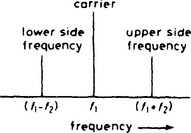
Figure S.18 Spectrum diagram illustrating the pair of side frequencies generated by 100% amplitude modulation by a sinusoidal signal
When the modulating signal is complex, as in sound broadcasting, each component in it gives rise to a pair of side frequencies so that two patterns of side frequencies are produced symmetrically disposed about the carrier. The spacing between the adjacent side frequencies is equal to the fundamental frequency of the modulating signal.
Side frequencies are also generated in frequency modulation and phase modulation but here a sinusoidal modulating signal produces several side-frequency pairs some of which can have an amplitude greater than that of the carrier as shown in Figure M.10. The side frequencies are symmetrically disposed about the carrier frequency and have a spacing equal to the modulation frequency. A complex modulating signal thus gives rise to a very large number of side frequencies theoretically extending to an infinite frequency. In practice, however, the amplitude of the outer side frequency components is small compared with that of the others and these extreme components can be filtered out without introducing appreciable distortion. Even so a frequency-modulated signal occupies a considerably greater bandwidth than the comparable amplitude-modulated signal.
signal In electronics an electrical quantity varying with time so as to convey information. In equipment, signals are usually in the form of varying voltages or currents but in the link between a radio transmitter and receiver signals have the form of modulated electromagnetic waves.
signal distance The number of digit positions in which the corresponding digits of two equal-length binary words differ. For example the signal distance between the two words 11100101 and 00100011 is 4.
signal generator Equipment for producing voltages or currents of controllable waveform, amplitude and frequency and used for the testing and alignment of electronic equipment. For receiver testing, signal generators are available giving modulated RF outputs.
signal processing or signal conditioning (US) The operations it is necessary to carry out on a signal to achieve the desired result. Typical operations are amplification, frequency changing, waveform shaping, mixing and gating.
signal-to-noise ratio In general the ratio of the power in the wanted signal to that of the noise which tends to interfere with it or mask it. It is usually expressed in dB. The precise way in which the signal and the noise are measured depends on the nature of the signal and the noise. For example RMS measurements are used for sound signals and random noise, peak-to-peak measurements for TV signals and impulsive noise.
Signal-to-noise ratio is a most important parameter of a communications system because system efficiency depends, in the final analysis, on the signal-to-noise ratio obtainable. Systems differ considerably in signal-to-noise ratio. For example amplitude limiting in FM systems permits a better signal-to-noise ratio than AM systems. In systems using pulse code modulation the ability to regenerate clean pulses from received pulses which are only marginally above the noise level makes possible very good signal-to-noise ratios.
silicon A tetravalent element (atomic number 14) widely used in the manufacture of semiconductor devices. In its pure state it is an insulator but by suitable doping, p-type or n-type conductivity of a value suitable for semiconductor device manufacture can be obtained. At normal temperatures leakage current is negligible in silicon devices. For this reason and also because silicon is more readily obtainable (in the form of its oxide it forms about 25% of the earth’s crust) it has virtually displaced germanium as the basic material used for semiconductor devices.
silicon alloy transistor An alloy transistor in which the base wafer is of silicon. The usual alloying element was aluminium but the transistors were not very successful primarily because of the difficulties caused by the different coefficients of expansion of silicon and aluminium.
silicon chip Popular name for silicon integrated circuit.
silicon controlled rectifier (SCR) Same as thyristor.
silicon controlled switch Same as tetrode thyristor.
silicon disk A bank of random access memory configured to simulate a floppy or hard disk and used for temporary storage of programs and data.
silicon epitaxial planar transistor A transistor manufactured by the planar process and making use of epitaxy.
silicon on sapphire (SOS) An example of a technology in which monolithic integrated circuit elements are fabricated in silicon on an insulating (sapphire) substrate. In this way the leakages and parasitic capacitances can be minimised so that the operating speed of a store fabricated in this way using field-effect transistors can approach that of a bipolar store.
silicon target vidicon A vidicon in which the target is principally composed of silicon. Silicon has high photoconductivity but its low resistance is an embarrassment. It is used in the form of a mosaic of individually-insulated pn diodes (with boron as the impurity) which are reverse-biased in normal use.
simplex operation A method of operation in which communication between two stations can take place only in one direction at a time. To effect two-way communication the direction of the link must be reversed. This can be achieved, in a radio system for example, by simultaneously switching the antennas at both ends from receiver to transmitter or vice versa. The same carrier frequency can be used for both directions. See duplex operation.
simulation In general, representation of one device by another. The second device must have characteristics similar to those of the first and is used in preference to the first because it is more convenient to use or easier to understand. For example an LCR network may be used to simulate the impedance of an antenna.
sinad ratio In mobile communications the ratio of the wanted signal, together with any distortion terms and noise to the distortion terms and noise. It is usually expressed in dB thus:
where
sine-squared pulse A single unidirectional pulse equal to the square of a sine wave and used for testing in TV. Such a pulse has a limited spectrum and the pulse duration can be so chosen that it is well suited for testing TV circuits. It is used in k-rating determinations. See raised cosine pulse.
singing In a transmission system unwanted sustained oscillation caused by positive feedback. The term is mainly used in telephony. In electronics the effect is usually termed instability.
singing point Of a system with positive feedback the point at which the gain of the system is just sufficient to cause sustained oscillation. The term has a more precise meaning in telephony. See Dictionary of Telecommunications (Butterworths).
single-ended push-pull A circuit in which a pair of active devices operating in push-pull are connected in series across the supply, the output being taken from their common point. The essential features of the circuit are illustrated in Figure S.19. If the two transistors are of the same type, as shown in (a), then the input signals applied to their bases must be in push-pull and a phase-splitting stage is necessary. If, however, the transistors are complementary, as shown in (b) they can both be driven by the same input signal and a separate phase-splitting stage is unnecessary.
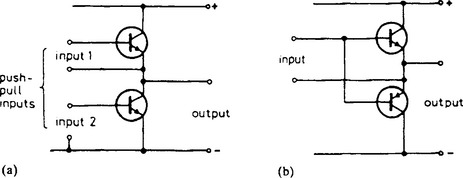
Figure S.19 Essential features of single-ended push-pull stage using (a) similar transistors and (b) complementary transistors
single in-line memory module (SIMM) An integrated circuit containing, usually, dynamic RAM. SIMMs are widely used in microcomputers where they make memory upgrades simple. To upgrade from 4 Mbytes to 16 Mbytes, e.g. might require the removal of four 1-Mbyte SIMMs and their replacement by four 4-Mbyte SIMMs.
single-shot circuit (US) Same as monostable circuit.
single-sideband transmission (SSB) A system of amplitude modulation in which only one sideband is transmitted, the carrier and other sideband being suppressed. The system has the advantage that it occupies only half the bandwidth of the corresponding double-sideband system. Reception is more difficult, however, because the missing carrier must be reintroduced at the receiver to permit detection.
sink A device which drains energy from a system. For example a heat sink is attached to electronic components with considerable dissipation to remove heat from them.
sinusoidal waveform A waveform in which the variable quantity is a sine or cosine function of time. For example a sinusoidal voltage waveform can be represented by the expression
where v is the voltage at a time t, Vo is the amplitude of the signal and ω is the angular frequency.
skiatron Same as dark-trace tube.
skin effect In a conductor carrying an alternating current a concentration of the current towards the edges of the cross section caused by interaction between the conductor and the electromagnetic field set up by it. The effect becomes more marked as the frequency of the current is raised and causes the effective resistance of the conductor to increase sharply with increase in frequency. At high radio frequencies so little of the current is carried by central areas of the cross section that a tube is as good as a solid conductor of the same diameter. It is common practice, in fact, to use copper tubing for the tuning inductors of radio transmitters. Skin effect can also be minimised by using a conductor consisting of a number of individually-insulated strands such as Litzendraht. See penetration.
skirt Of the amplitude-frequency response curve of a resonant circuit, those parts of it away from the peak where the two halves of the curve diverge.
slant polarisation See elliptical polarisation.
slew rate (1) Of a power supplier a measure of the speed with which the output voltage compensates for changes in the current drawn. It measures the maximum rate of change of voltage across the output terminals. (2) Of a differential amplifier the rate of change of the output voltage when a step signal is applied to the input terminals.
slicing The process of suppressing those parts of a signal waveform which lie outside two amplitude boundaries, allowing only those parts which lie between the boundaries to pass on. The process is illustrated in Figure S.20.
slope Same as mutual conductance.
slope detector A detector for phase- or frequency-modulated signals which depends for its operation on the slope of the skirts of the amplitude-frequency response curve of a resonant circuit.
If the difference between the resonance frequency and the centre frequency is suitably chosen the frequency variations are converted to amplitude variations (Figure S.21) which can be demodulated by an AM detector. Unfortunately the amplitude-frequency relationship of the skirts is not linear and the slope detector inevitably gives considerable distortion. This can, however, be minimised by using the skirts of two resonant circuits in a push-pull arrangement as in the Round-Travis discriminator.
slope resistance Of a non-linear resistance the ratio of a small change in applied voltage to the resulting change in current. It is measured by the reciprocal of the slope of the current-voltage characteristic at the operating point and in general depends on the position of that point. For example in Figure S.22 the slope resistance is high at A, and low at B and infinite at C.
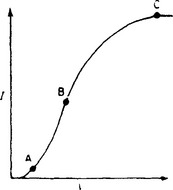
Figure S.22 Characteristic for a non-linear resistor showing variation of slope resistance with the position of the operating point
slow-wave circuit (US) Same as slow-wave structure.
slow-wave structure In travelling-wave tubes a structure used to reduce the axial velocity of electromagnetic waves to a value equal to the electron-beam velocity to permit the interaction which leads to amplification. The usual form of slow-wave structure is a helix, the ratio of the pitch to circumference being chosen to give the required axial wave velocity.
slug (1) A small cylindrical plug of permeable or conducting material introduced into a coil to adjust the inductance. A permeable slug increases inductance whereas a conducting slug (acting as a short-circuited turn) reduces it. If the slug and coil former are threaded, inductance can be adjusted by screwing the slug in or out, so making slug tuning possible.
(2) A short-circuited winding placed on the core of a relay to introduce a time lag in its operation.
small-scale integration (SSI) See monolithic integrated circuit.
Small Computer Systems Interface (SCSI) A standard for linking computers to peripherals such as printers and scanners. The advantage of SCSI over other standards is that a number of peripherals can be daisy-chained together so that they share the same port on the computer. This reduces the requirements for ports on the computer and can also save cabling costs.
smart A vague term used to describe almost any kind of device which, with the aid of electronics, has acquired some facility for automatic control.
smart card A device which looks like a credit card, but in fact contains electronic circuitry. When this is connected to a suitable host device, it may provide a variety of services. It may, e.g. carry confidential information about the card’s owner, such as a full medical record. Alternatively it may contain details of the owner’s bank account, which are automatically updated as transactions take place.
smearing In TV, blurring of the verticals in a reproduced image.
Smith chart or Smith diagram Same as circle diagram.
smoothing The attenuation of the ripple component in the output of a rectifier.
smoothing circuit Same as ripple filter.
sneak current An unwanted current that flows in a circuit, usually as a consequence of poor circuit design rather than of defective components.
soak testing Of a component or equipment, a prolonged period of operation under normal conditions. The test is often used as a means of detecting intermittent faults, diagnostic instruments being connected to the equipment to call attention to the faulty condition.
soft keys Same as function keys.
soft tube See gas-filled tube.
software For computers and data-processing equipment the programs, routines, data and on-line documentation required for their operation. See also hardware.
solar battery or solar cell Device for the direct conversion of solar energy to electrical energy. Such devices commonly use the photovoltaic effect of silicon diodes and a single cell gives an EMF of about 0.5 V. A series-parallel arrangement of cells is necessary to provide a battery with a useful output voltage and current. Solar batteries are used to power telephone repeaters in isolated situations and to power space vehicles.
solder An alloy of tin and lead used for making permanent low-resistance joints between metal surfaces. The solder must ‘wet’ the surface for a satisfactory joint and a flux is used as a cleaning agent.
solenoid An electromagnetic device consisting of an inductor with a hollow core in which a bolt of ferromagnetic material, the armature, is free to move. The magnetic field set up by an electric current in the inductor attracts the armature deeper into the core of the inductor. When the current stops flowing and the magnetic field disappears, the armature may return by spring action or may remain in its present position until another inductor in line with the first is energised and draws it away. Solenoids form part of electromagnetic relays and are widely used in the electrical and electronic control of machinery and industrial processes.
solid state Adjective used to describe a device, the operation of which depends on the structure and properties of a solid, particularly a semiconductor.
sound Subjectively, the sensation produced when the ear responds to vibrations within a certain frequency range. Objectively, the vibrations themselves which are propagated as longitudinal waves in gases, liquids and solids. See audio frequency.
Soundblaster The popular name applied to the sound synthesis cards fitted in some IBM PC-compatible computers to provide the sound effects used in games and multimedia presentations.
sound cell A piezo-electric element used in microphones and consisting of two crystal bimorphs (bender types) mounted back-to-back with a small air space between them. The construction of a sound cell is illustrated in Figure S.23. A number of such elements may be connected in parallel to increase microphone sensitivity.
source Of a field-effect transistor the connection to the channel from which majority carriers enter the channel. It corresponds with the emitter of a bipolar transistor and the cathode of an electron tube.
source AC resistance See electrode AC resistance.
source code A computer program in the form from which it is compiled or assembled into machine language (the object code). See computer language.
source follower The field-effect-transistor equivalent of the emitter follower and the cathode follower.
space charge In general the net electric charge due to a collection of ions or electrons in space. In an electron tube the accumulation of electrons in the region between the cathode and the control grid. The electrons leave the heated cathode with an initial velocity which is soon reduced to zero by the negative charge on the grid and the positive charge on the cathode caused by the loss of electrons. Some electrons return to the cathode but others are being constantly liberated so that a cloud of them gathers in the grid-cathode space. A similar space charge occurs in a pentode between the screen grid and the suppressor grid. See virtual cathode.
spark Conduction of an electric current of high density and of short duration through an ionised gas. See arc.
specific inductive capacity (SIC) Same as permittivity.
specific resistance Of a material, the resistance between opposite faces of a cube of the material of 1-cm side. The unit is the ohm-cm but for most good conductors the specific resistance expressed in this unit is very small and it is more convenient to use the micro-ohm-cm. For example the specific resistance of copper is 1.66 μΩ-cm.
spectrum (1) A continuous range of frequencies for which the waves have a specified common characteristic. For example the audio spectrum occupies the range between 20 Hz and 20 kHz approximately, the common characteristic being that the human ear can respond to waves of such frequencies. See electromagnetic waves. (2) Of a complex signal, the distribution of the components with frequency. For example a rectangular wave has a spectrum consisting of uniformly-spaced components, the amplitudes of which decrease with increasing frequency.
spectrum analyser An instrument which resolves complex waveforms into their components and displays the result on the screen of a cathode ray tube, the horizontal axis representing frequency and the vertical axis the amplitude.
speech coil Of a moving-coil loudspeaker or microphone, the coil which is attached to the diaphragm and to which the audio-frequency input is applied or from which the audio-frequency output is taken.
speed-up capacitor Capacitor bridging the coupling resistor in a multivibrator circuit to improve the rise time of the output pulses. In a bistable circuit as shown in Figure S.24 the edges of the output waveforms are not as steep as they could be because the inter-transistor couplings consist of the resistors R3 and R4 which, in conjunction with the input capacitances of the transistors, introduce a high-frequency loss. This can be offset by bridging R3 and R4 by capacitors C1 and C2 which, if of a suitable capacitance, can make the coupling circuit aperiodic.
spherical aberration In an optical lens or mirror, lack of definition in the image caused by rays emanating from a point in the object failing to meet at a point in the image area. The defect is caused by use of spherical surfaces in the lens or mirror: it could be eliminated by use of parabolic surfaces.
spherical wave A wave of which the front is a spherical surface. A wave originating from a point source has such a front, the source being the centre of the spherical surface.
spike A transient of short-duration which occurs during the reproduction of a pulse.
spiral scanning A form of scanning in which the spot on the screen of a cathode ray tube moves around the centre of the screen at constant angular velocity gradually moving inwards or outwards in a spiral path, with a rapid return to the edge or centre at the end of the scanning stroke.
split-beam oscilloscope Same as double-beam oscilloscope.
spot In cathode ray tubes the small area of luminescence on the screen where the electron beams strike it. Efforts are made in the design of cathode ray tubes and the associated circuitry to keep the spot area as small as possible in order to improve the definition of the display.
spot wobble A technique used in black-and-white TV receivers to make the line structure of the displayed image less obvious by superimposing a vertical oscillation of very small amplitude on the scanning spot by use of an oscillator working at a frequency well above the video band.
spread Of characteristics the limits between which the properties of a manufactured component may vary from the published nominal value.
spurious emission or radiation From a radio transmitter any radiation at a frequency other than the intended frequency, e.g. at a harmonic of the carrier frequency.
spurious oscillation See parasitic oscillation.
spurious response Any response from a device or equipment other than the wanted response. For example second-channel response in a superheterodyne receiver is a spurious response.
square-law detector A detector for which the output signal is directly proportional to the square of the input signal over the useful range of the device. The anode-bend detector can be regarded as an example because the Ia–Vg characteristic of an electron tube near anode-current cut off is an approximation to a square-law curve.
square wave A wave which regularly alternates between two fixed values of amplitude, spending equal time at each, the times of transition between the values being negligible compared with the period of wave. The waveform of an ideal square wave is shown in Figure S.25. It contains a wealth of odd harmonics and is extensively used for testing and for timing purposes in electronics.
squegging The generation of an oscillation, amplitude modulated by a relaxation oscillation. Squegging can occur in an oscillator in which there is very tight coupling between input and output circuits, resulting in a very rapid build-up of oscillation amplitude which is sufficient to cut off the active device. Oscillation therefore ceases until the active device is able to conduct again, whereupon the process repeats itself. A blocking oscillator is an example of a squegging oscillator in which the periods of conduction are sufficient for only half a cycle of oscillation.
squelch Same as quiet automatic gain control.
s-signal In stereophonic sound broadcasting one half the difference signal.
stabilisation (1) Of a power supply the process of ensuring that the output voltage is always at the intended value. Stabilisation implies regulation and some information on the circuits used for the purpose are given under regulation.
(2) Of the working point of an active device the process of ensuring that the mean current through the device is always at the intended value. A number of circuit techniques are available for stabilising the working point. An example is shown in the transistor circuit of Figure S.26. R1 and R2 form a potential divider across the supply and impress a particular value of voltage on the base. By emitter-follower action this voltage appears at the emitter (less 0.7 V approximately in silicon transistors) so fixing the emitter voltage. R3 is now chosen so that the desired mean emitter current is obtained. Thus if the base voltage is 3.0 V, the emitter voltage is 2.3 V and if R3 is made, say 1 kΩ, the emitter current is stabilised at 2.3 mA.
stabilising mesh The mesh situated near the target of a low-velocity TV camera tube and biased positively with respect to it to prevent instability of the target potential by effectively limiting the maximum potential which it can develop. For small light inputs to the camera, the mesh collects the secondary electrons emitted from the target with the result that the target develops a positive charge image. If, however, any area of the target tends to become more positive than the mesh potential then the electric field between mesh and target returns the secondary electrons to the target until the target potential equals the mesh potential. Thus no area of the target can develop a potential exceeding that of the mesh. See camera tube, image orthicon, orthicon.
stability In general, of equipment, the extent to which a specified feature of its performance can be maintained in spite of variations in supply voltage, temperature or other factors which can affect performance. For example the stability of an oscillator is measured by the deviations in frequency from the nominal value.
stagger tuning The process of obtaining a level response over a desired bandwidth by tuning the resonant circuits to particular frequencies within the passband. This technique is used, for example, in the IF amplifiers of TV receivers and in the multi-cavity klystrons used in TV transmitters.
standard cell A primary cell the EMF of which remains constant with time and is used as a reference standard. To maintain the constancy of the EMF very little current must be taken from the cell which is not therefore used as a source of power. The best-known example of a standard cell is the Weston cell.
standard radiator Same as full radiator.
standby mode The state in which an equipment is not fully operational, but can be brought into operation instantly if required.
standing current Same as quiescent current.
standing wave On a transmission line a stationary pattern of voltage or current produced by interaction between a sinusoidal electromagnetic forwards-travelling wave and the wave travelling in the opposite direction after reflection at an impedance discontinuity. The interaction gives rise to alternate nodes and antinodes of voltage and current along the line, the distance between neighbouring voltage nodes (or antinodes) being equal to the wavelength. Acoustic standing waves can also occur, e.g. in an enclosure such as a room, by interference between a wave before and after reflection at a wall. Such standing waves are responsible for the acoustics of a hall.
star-delta transformation A method of simplifying network problems by replacing a star (or delta) network by a delta (or star) network which at a particular frequency has the same properties. The transformation is the same as that between T- and π-networks and for equivalence the following relationships apply (see Figure S.27):
star network A network with three or more branches, one terminal of each being connected to a common point. Figure S.28 shows a star network. When there are three branches the network may alternatively be termed a T-network or Y-network.
starting anode or starting electrode In a gas-filled tube an electrode used to initiate the ionisation which causes the main discharge.
static characteristics Of an active device, characteristics representing the relationship between the current at one electrode and the voltage at the same or other electrode, with all other voltages constant and with no load connected to the device. By superimposing a load line on the static characteristics it is possible to deduce the dynamic characteristics representing working conditions.
static error An error which is independent of a time-dependent variable. C.f. dynamic error.
staticise In computers to store serial or time-dependent data.
static random-access memory (SRAM) A volatile store in the form of a matrix of cells, each consisting essentially of a bistable of bipolar or insulated-gate field-effect transistors. Within each cell additional transistors provide inputs and outputs for reading and writing purposes, giving a total of 4 or 6 transistors per cell. Such a store retains inserted data provided the power supply is not interrupted. There is no need for refreshing as in a DRAM.
static sensitive device A transistor or integrated circuit which may be damaged or even destroyed by the static charges generated by handling it if special discharging procedures are not adopted. CMOS devices are often of this type.
static store Same as static RAM.
stationary wave Same as standing wave.
steady state Of a system or equipment the condition when all transient phenomena have ceased and the voltages and currents are steady or varying sinusoidally between constant peak values.
steering diodes In a bistable circuit, diodes which direct incoming trigger signals alternately to the two elements of the circuit so that it is successively switched between its two possible states. Thus if the triggering signals are regular the steering diodes ensure that the bistable circuit generates square waves at half the trigger frequency.
step function A function which has a value of zero until a particular time at which it instantaneously assumes and maintains a constant finite value.
step recovery diode A semiconductor diode notable for the speed with which it ceases conduction when reverse-biased. It consists of a substrate of n-type silicon carrying a thin region of lightly-doped n-type silicon and an upper region of p-type silicon. When the diode is forward-biased, charge is stored in the centre region. When the diode is reverse-biased this charge falls and, when it is fully depleted, current through the diode cuts off very suddenly. If such a diode is regularly pulsed into conduction, the current contains a train of regularly-spaced steep edges which can be used to excite a resonant circuit into oscillation, so enabling an input at one frequency to give an output at a different frequency. See frequency multiplier.
step response Of a system or equipment, its response to a signal in the form of a step function.
Stereocasting (US) Stereophonic broadcasting.
stereophonic system A system of sound broadcasting or recording and reproduction which gives listeners an impression of directionality and spatial distribution of sound which greatly enhances the realism of reproduction. The system may use a number of spaced microphones, an equal number of channels and the same number of spaced loudspeakers but, in broadcasting and recording, only two channels are normally employed and the system is compatible so that satisfactory monophonic reproduction of the stereo signal is possible.
sticking An effect in a TV camera tube which has been subjected to a stationary optical image for a long period whereby the tube continues to give a picture signal of the image after the image has been removed. In image orthicon tubes the effect occurs immediately after switching on because the target resistance is too high and the charge image persists longer than in normal operation.
stopper See parasitic stopper.
storage battery or storage cell Same as secondary cell.
storage camera tube A camera tube in which a charge image corresponding to the optical image input grows in magnitude on the target until neutralised by the scanning beam. This occurs in all the camera tubes such as the iconoscope, image iconoscope, orthicon, image orthicon and vidicon which have been successfully used in television services. Storage occurs by virtue of the capacitance of the target and it brings about a considerable increase in the sensitivity of the tube. In fact it was not until the advantage of the storage principle was appreciated that tubes sensitive enough for use in television services became possible.
storage element Of a computer store, the smallest element of storage, e.g. a memory cell.
storage tube An electron tube into which information can be fed for later reading. The stored signal can be displayed as a visible image on the screen or can be retrieved as an electrical signal.
A simplified diagram of a storage tube is given in Figure S.29. The phosphor target is backed (on the viewed face) by a transparent conductive layer. The writing gun is maintained negative with respect to the target to attract electrons which are focused to a fine spot on the target, causing it to luminesce. By applying potentials to the deflecting plates the beam can be deflected so as to write on the screen.
Part of the writing beam is intercepted by the storage mesh and strikes it with sufficient velocity to release secondary electrons. For each beam electron striking the mesh, several secondaries are released (i.e. the secondary emission ratio is greater than unity). The secondaries are attracted to the nearby collector mesh, causing the storage mesh to go positive in the areas struck by the beam. Thus the display is written on the storage mesh as a positive charge image. The cathodes of the flood guns are only slightly negative with respect to the target potential but electrons are attracted by the positive areas of the storage mesh and pass through it to enhance the display on the phosphor.
Once a charge image has been established on the storage mesh the trace continues to be displayed on the screen for a considerable period—under favourable conditions for up to an hour. In fact if the tube is switched off, a charge image can last for a week.
To erase the display a positive pulse can be applied to the target. This attracts electrons from the flood guns which are designed to flood the entire area of the screen with electrons so ‘writing’ the entire screen area. As the target potential falls at the end of the pulse the screen is erased.
By restricting the intensity of the beam from the writing gun it is possible to write on the phosphor screen without building up a charge image on the storage mesh—a technique known as ‘writing through’.
Such tubes have very high resolution and give a flicker-free display.
store Of a computer, the device into which information can be fed for retention until required. There are a number of different types of storage device, some using magnetic disks or tape, some using capacitors or bistable electronic elements. See bistable circuit, magnetic core, magnetic drum, memory cell, RAM, ROM.
‘straight’ receiver Same as tuned-radio-frequency receiver.
stray capacitance In electronic circuits the capacitance arising from all sources other than from capacitors. Thus stray capacitance can arise from within active and passive components and from the proximity of components, conductors and chassis. Stray capacitance is undesirable because it limits gain at high frequencies by shunting loads but it is sometimes put to good effect as part or whole of the tuning capacitance of a resonant circuit. See distributed constants.
streaking In TV an effect in which areas of incorrect tonal rendering appear to the right of vertical lines in the image. In black-and-white television the streaks may be black or white following black or white lines and can occupy any fraction up to the whole of the picture width. The effect is caused by anomalies in the amplitude and/or phase response in the video chain at frequencies around the line frequency.
string In computing, a sequence of bytes, often representing text.
strip (US) Same as scanning line.
strobe To select a particular fraction of the period of a recurrent event. This is often necessary in detailed examinations of a regular waveform using an oscilloscope. A strobe pulse which coincides in time with the wanted part of the waveform is used to gate the waveform and then to display it.
Structured Query Language (SQL) A language devised by IBM for creating, maintaining and viewing data in a database. It is now becoming an industry standard and may provide a means for different computer types running different databases to extract data from each other.
stub An open-circuited or short-circuited length of transmission line, usually less than a quarter wave, connected across a transmission line to facilitate matching of the line to a load.
subaudio A frequency below the normal audio range. The lower audio limit cannot be accurately defined but a subaudio frequency can be taken as one below 15 Hz.
subcarrier A carrier, usually with modulation, which is used to modulate another (main) carrier. Subcarriers are used extensively in telephony. They are also used in stereo sound broadcasting (to carry the difference signal) and in colour television (to carry the colour information). The subcarriers are ignored when compatible monophonic or black-and-white reproduction is required.
subdirectory Any directory other than the root directory.
subharmonic Of a complex wave a sinusoidal component with a frequency that is an exact submultiple of that of the fundamental component. For example the second subharmonic has a frequency equal to one half that of the fundamental component.
subjective grading Of the performance of an equipment or system a method of grading in which a panel of observers record their assessments according to a scale. For example interference to a sound or TV programme can be classified as negligible, slightly distracting, distracting, very distracting or completely distracting.
submodulator Of a transmitter, the penultimate stage of the modulator.
subroutine In computers part of a program generally used more than once in the program and dedicated to the carrying out of particular operations. A typical example is the display of text characters.
subschema The user’s view of data in a database.
subset A piece of software which is a shortened and therefore incomplete version of some other software. Subsets of computer languages, for instance, may contain only the principal keywords.
substrate In general, the supporting material on which or in which a monolithic integrated ciruit is fabricated. In many semiconductor devices the substrate is a layer of monocrystalline silicon. In a field-effect transistor the substrate supports the channel, the source and the drain. In some types the substrate forms a pn junction with the channel: a connection to the substrate can then be used as a second gate terminal. In other types of FET, however, the substrate is insulated from all parts of the transistor.
summing amplifier An operational amplifier with a negative feedback network so designed that the output is equal to the sum of the input signals. Such amplifiers are used in analogue computers.
sum signal In stereo broadcasting the signal formed by adding the signals in the left and right channels. In the pilot-tone system of transmission the sum signal is used to frequency modulate the main carrier and it is this signal which is reproduced by a monophonic receiver.
super-alpha pair Same as Darlington pair.
superconductivity The virtual disappearance of electrical resistance in certain metals at temperatures approaching absolute zero. The effect is pronounced in copper and zinc around 5°K and currents induced in a ring of these metals by movement of a magnetic field continue to flow for some hours afterwards.
super Emitron Same as image iconoscope.
superheterodyne receiver A radio receiver in which the modulation of all incoming signals is transferred to a new fixed carrier frequency (the intermediate frequency), most of the gain and selectivity of the receiver being achieved in the IF amplifier.
Frequency changing is achieved by mixing the incoming signals, possibly after amplification, with the output of an oscillator, the tuning of which is ganged with that of the signal-frequency circuits so that the mixer output remains at the intermediate frequency for all settings of the tuning control. The IF amplifier is followed by a detector or discriminator and subsequent modulation-frequency amplifiers as required.
The block diagram of a superheterodyne receiver is shown in Figure S.30 and this applies to AM and FM sound receivers and to the basic structure of TV receivers. Practically all modern receivers utilise the superheterodyne principle. The term is a telescoped form of supersonic heterodyne, a reference to the fact that the IF is above the audible range.
superposition theorem The current flowing at a point in a linear passive network, as a result of the simultaneous application of a number of voltages distributed in any manner throughout the network, is the sum of the component currents at that point which would be caused by the individual voltages acting separately. Similarly the potential difference existing between any two points in the network as a result of the several applied voltages is the sum of the component potential differences between the points which would be caused by the individual voltages acting separately.
super-regenerative receiver An AM receiver incorporating a detector which is taken in and out of oscillation at an ultrasonic rate, so achieving higher gain than is normally possible without instability. A grid-leak detector with reaction is capable of high gain but the gain is limited by the onset of oscillation. The super-regenerative principle avoids this limitation by allowing oscillation to build up and then quenching it at an ultrasonic frequency. It is possible to achieve RF and ultrasonic oscillation in a single active device but better results are possible with a separate ultrasonic oscillator.
suppressed-carrier modulation A system of amplitude modulation in which both sidebands are transmitted, the carrier being suppressed. Because the carrier component remains constant, whether there is amplitude modulation or not, it is clear that the carrier can be suppressed, all the information being contained in the sidebands. It is necessary, however, to re-insert the carrier at the receiving end to permit detection.
suppressor grid An electrode situated between the screen grid and anode of an electron tube to prevent secondary emission from the anode from reaching the screen grid. The suppressor grid is normally connected to the cathode to form a decelerating field near the anode which returns secondary electrons to the anode. In this way the tetrode kink can be eliminated so improving the ability of the tube to handle large output-voltage swings.
surface acoustic wave device (SAW) A device which makes use of radio waves in the form of surface deformations on piezo-electric materials. Such waves can be excited by suitable transducers and they have wavelengths about 105 times smaller than those in free space. Thus the wavelength of a 35-MHz wave is less than a millimetre and it is possible by suitably shaping the piezo-electric surface to produce an extremely-small filter by techniques similar to those used in microwave filters. Bandpass filters of this type are used in the IF amplifiers in TV receivers and there is likely to be considerable development in this type of structure in the future.
surface-barrier transistor A bipolar transistor in which the emitter and collector regions are formed by electrodeposition of a trivalent or pentavalent element on opposite faces of a thin base wafer.
surface mounting A method of mounting specially-designed components and integrated circuits on a printed wiring board by soldering the contacts of the components directly to the tracks, so eliminating the need for holes in the board. The method permits greater component packing density, gives higher speeds of operation and much improved thermal performance.
surface noise In record reproduction the noise produced by the stylus passing through the groove. There is very little surface noise from modern records but earlier types were of shellac incorporating an abrasive material and the minute irregularities in the groove walls caused a pronounced hiss on reproduction. See scratch filter.
surfing Jargon for browsing on the Internet, which some computer users find an absorbing pastime.
surge impedance Same as characteristic impedance.
surround sound Same as quadraphony.
susceptance (B) That component of the admittance of an alternating-current circuit which is due to its inductance and/or capacitance. It is the imaginary component of admittance and, for a circuit containing only susceptance, the voltage and current are in quadrature. Susceptance is the reciprocal of reactance. For an inductance L the susceptance (in mhos) is given by
and for a capacitance C
where ω is the angular frequency. The signs follow the same convention as for reactance.
susceptibility Of a magnetic material the ratio of the intensity of magnetisation to the magnetising force. For an isotropic material the susceptibility is equal (in rationalised units) to the relative permeability less one.
sweep The regular movement of the spot across the screen in a cathode ray tube or the change in frequency across the band in a wobbulator output.
sweep oscillator (US) Same as wobbulator.
swept-frequency generator Same as wobbulator.
swing The difference between the extreme values of current, voltage or frequency of a signal.
swinging choke A series inductor used for smoothing and located immediately following the output of a rectifier. To improve regulation the choke is designed so that its effective inductance decreases with increase in the current through it.
switch A device for breaking (opening) or making (closing) an electric circuit. Switches can be mechanical, e.g. those controlling electric lights, or they can be electronic (consisting of transistor or thyristor circuits) such as those used in electronic telephone exchanges.
switch-mode power supplier A DC power supplier with an AC input and in which the smoothed output from the rectifier is chopped into pulses which are then rectified and smoothed to provide the output, the mark/space ratio of the pulses being automatically adjusted to regulate the output voltage. The chopping device may be self-oscillating or may be driven from a pulse generator, such as an astable multivibrator, within the power supplier. Such power suppliers can be made highly efficient and much more compact than conventional types. One reason for this is that by using a high pulse frequency only small smoothing components are needed. (In power suppliers for television receivers the pulse generator is often synchronised at line frequency.) Another reason is that the active device acting as chopper operates as a switch and (except for the instants of switching) has zero current in it or zero voltage across it; dissipation in the device is thus minimal. See regulation.
syllabic companding Companding in which the changes of gain are fast enough to follow the syllables in speech but not the individual cycles of the speech waves.
symmetrical deflection Of a cathode ray tube, electrostatic deflection in which the deflecting voltages applied to the plates are symmetrical about a reference potential (usually the final-anode potential). Such a system gives less geometric distortion of the image than asymmetric deflection.
symmetrical operation Same as push-pull operation.
synchrodyne A system of heterodyne reception in which the oscillator operates at the carrier frequency of the received signal and is synchronised by the received signal. It is an example of heterodyne reception in which the intermediate frequency is zero, the output from the frequency changer being at modulation frequency.
synchronising signal In TV the signals which ensure that the horizontal and vertical scanning circuits in picture-display equipment are synchronised with the picture-generating equipment. In colour TV the synchronising signal includes the colour burst which synchronises the chrominance decoder. The synchronising signal is added to the picture signal to form the video signal.
synchronous detector A detector sensitive to phase and amplitude variations in the modulated signal applied to it. Such detectors are used for independently recovering the two components of the chrominance signal from the quadrature-modulated subcarrier in the NTSC and PAL colour TV systems. For successful operation the detector must be synchronised with the reference signal (colour burst) contained in the TV colour signal.
synchronous logic In data-processing logic in which all operations start on receipt of a signal from a clock. C.f. asynchronous logic.
synchronous tuning Tuning in which all the resonant circuits are adjusted to the same frequency.
sync level In TV the level reached by the peaks of the synchronising signals. See Figure B.18 (a).
synthesiser An electronic musical instrument which produces a wide repertoire of sounds using digital techniques to construct the required output waveform.
system A complex of conductors, components and equipments interconnected so as to perform a particular function. For example, a radio receiver can be said to have an a.g.c. system and a collection of antennas can form a diversity system.
